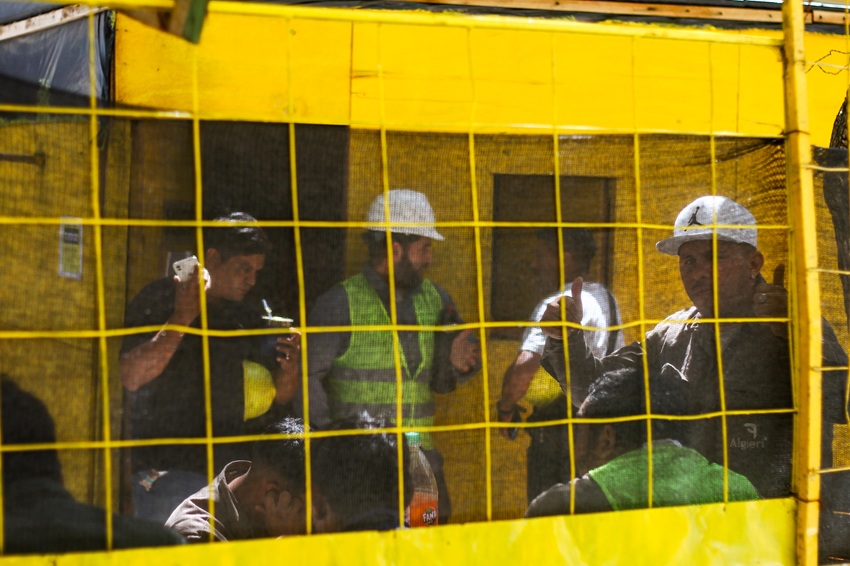
He dollar It fell just a little in the first days after 26O but then returned to values close to the ceiling of the exchange rate band (the wholesaler is still above $1,450). The indicator country risk prepared by JP Morgan was the one that adjusted downwards the most, hovering around 650 points from levels above 1,000, a level insufficient to access external credit that allows the Government to refinance maturities.
“The markets” seem to indicate the direction to the government: the variables are relatively calm, avoiding the lack of control to which they seemed to inevitably be heading weeks before, but they keep pressing expectantly For Milei to give them more of what they came looking for: conditions of greater profitability through socially regressive reforms.
The debt crisis is the forest
The government obtained a breath by the hand of Trumpa new survival, but it is very far from having resolved the financial crisis. With the current level of the backward dollar fails to accumulate reserves and will once again fail to meet the goal with the IMF of an accumulation of USD 8.5 billion of net reserves.
For financial capital, the exchange rate uncertainty is not over: they are not sure that the government will continue with the current band scheme for so long. the expectation of devaluation remaining latent and pressure on the dollar.
If the government of Front of All did not make the slightest attempt at cast doubt on the legitimacy and illegality of the debtNeither will Milei’s government. From the first day he placed the payment of the foreign debt in first place in the hierarchy. Likewise, he contributed to his increase: Total gross debt grew 23% between December 2023 and August 2025totaled US$ 83,500 million and reaches US$ 454,230 million.
To have a dimension of the weight of those senfoundations, in 2025 the economic turbulence and the two bailouts (IMF and Trump) in less than six months, occurred with levels of maturities in foreign currency of US$9.2 billion. By 2026 they will rise above the US$19 billion. For the period 2026-2035, commitments average US$28 billion between principal and interest maturitiesaccording to data from the Ministry of Finance.
¿How are you going to face the next payments?which between 2026 and 2027 they average US$ 15,000 million? A report of the Province Bank It rules out that, given the current exchange rate level, the government can do so with its own reserves (they are not enough), that it manages to attract a flow of foreign investments (it is at historic lows), or that a portfolio investment scheme (short-term speculative, which is in decline) will be reopened. A new IMF loan would be practically ruled out, since Argentina already has a third of the Fund’s portfolio.
Therefore, unless we want to carry out a devaluation that is large and regressive enough to achieve an extraordinary current account surplus, the only way left is to reopen external credit. To do this, he needs trust from the markets, and Trump’s support or Bessent’s tweets do not seem to be enough. Rather, the desperate call for help exposes fragility.
Banco Provincia analyzes the iArgentine sustainability indicators and finds the explanation for the distrust of “the markets” with the most market-friendly that they could have gotten.
1) “In line”: The Fund is a collector of first instance, so private creditors would be in second place – or third, if the United States Treasury were added in a possible restructuring scenario.
2) Reserves in relation to GDP They are only 6.5%, far behind the 20% of other IMF debtors that accessed private credit such as Ukraine, Ghana, Angola, Egypt and Kenya.
3) Above all, the debt in dollars in relation to reserves is 648% (7 times the reserves), when the average of those countries is half.
4) The Fund has 20% of the total Argentine debt in foreign currency, for those reference countries it is 8%.
5) The current account deficit reaches 3.2% in Argentina, while these countries have a current account surplus of up to 1.7% of GDP.
The government’s strategy would be summarized in “kick the problem”, or the old recipe of taking on new debt to pay old debt, turning to credit “markets.” This is what he has been aiming for since he began his administration, but without success. When the Government fails to meet the goal with the IMF again at the end of the year, it will add even more distrust to potential external lenders.
How then does it seek to sweeten the ears of big capital? With greater submission and the fulfillment of “promises” to impose more on the working people. Labor reform enters the scene. Trump has a mandate to do so with political agreements with governors, Peronism and unionism, which lend themselves to being “collaborators” in that negotiation.
A new chapter of labor reform
The supposed objective of the reform is to create more registered employment, based on old arguments such as that the legislation is outdated, that there is a “de facto labor reform” in a labor market that has 50% informality and then “something has to change” (remove rights) so that there is more employment and lower precariousness.
Has reducing “labor costs” ever worked for job creation? What would be the definition of “precarious” in a scheme of flexibility and intensification of working times, rhythms and conditions to the absolute needs of capital? How will social security and pensions be financed, how will job stability be guaranteed without compensation?
The economist Gaston Remy refutes it with the example of Ledesma
In this graph I explain why Milei’s Labor Reform and big businessmen: it is NOT + employment, it IS + profits for big businessmen. The case of the Ledesma group confirms this. pic.twitter.com/BsjHfE1lVQ
— Gastón Remy (@RemyGaston1) November 6, 2025
It is worth saying that a first chapter of the labor reform made progress with the base laws, especially the partial legalization of social security fraud, which is the dependency relationships hidden with figures such as those of the Monotributo, greater facilities for dismissal without cause, the extension of the trial period from 3 to 6 months, the elimination of fines for unregistered employment, the creation of the “employment termination fund” (which is not being applied in fact except in the construction that came before) and especially, in a limitation on the legitimate right to strike.
The specialist explains this very well. Luis Campos (Social Law Observatory, CTA-A) in this interview, where he also indicates “what was missing” for the desires for labor slavery to materialize: advancing in the field of collective labor relations.
That is, “everything that has to do with unions and the relationship with employers’ chambers, collective labor agreements, the right to strike, financing of unions, everything that had been in the DNU and whose validity was suspended by an order from the National Chamber of Labor Operations.”
Although there is no closed project in the Executive, the statements of officials such as Milei and Julio Cordero (Secretary of Labor) They indicate that path, that of destroying every remaining vestige of union and collective organization of workers to demand rights, and taking it even further to individual negotiations, where the worker is left at a total disadvantage.
The changes aim to: prioritize work agreements by company, instead of collective agreements, limit the cost of compensation much more (there is talk of a limit of up to 10 months), and limit salary increases to productivity, among the main points.
Paradoxically, Those who should be on the front line rejecting such attacks are the ones who first announced that they would sit down to negotiateeven before the 26O elections: the union centers, especially the CGT.
The ruling party “raised” the bar of the discussion by allowing a project of a LLA legislator, Romina Diezin which there is even talk of the possibility of the working day being extended to 12 hours. A crude attempt to scare and then “negotiate”.
They prepare a new failure
The offensive of capital under Milei’s neo-liberation project seeks to implement a deep and accelerated transformation of the entire economic structure and the relations between classes. In the 1990s, the experience of Convertibility shows how the sustained exchange rate delay in a dependent and backward country like Argentina, leads to deep imbalances, economic recession and increase in unemployment, underemployment, precariousness and poverty.
At that time “the most concentrated sectors of the national bourgeoisie together with the imperialist capital based in the country They took advantage of the conditions of stability to aggressively resume the offensive to restructure the country’s economy. in terms that were favorable to them, attacking the working class and the popular sectors and also disciplining other fractions of the business community. The “exchange corset” became a formidable battering ram to forcibly restructure the Argentine economy,” explains Esteban Mercatante.
In the scenario that the government manages to agree on some type of labor reform that pleases financial capital and Trump, lowers the country’s risk sufficiently with the extension of a backward exchange rate, manages to access the international credit market and this allows it to face next year’s maturities, What it will have achieved is to postpone the financial front for a time, but far from solving the problems of economic stagnation, bankruptcy of the productive apparatus and destruction of employment, it will exacerbate them.
As they point out Aninus and Mercatante in this medium, “In the last decade and a half the country has not been able to get out of the trap: in the context of stagnation of the economy since 2012 (and decline in terms of GDP per capita), the few years in which the economy grows the exchange balance of the Central Bank becomes negative and, therefore, reserves are not accumulated. That is why it goes through the debt crisis like a backpack that it cannot get rid of.”
He peronism granted the right the mantras of its model: fiscal balance at all costs, commodity export consensus and labor reform. Without pointing out any of the manifest weaknesses of the Milei government, it only proposes negotiating to attempt some damage control.
Far from it, The only viable alternative for working people is to face the offensive of capital with the broadest organization, so that the only labor reform that exists is one that guarantees work with rights to all, salaries at least equal to the family basket and reduction of the working day to have time to live.
Source: www.laizquierdadiario.com

